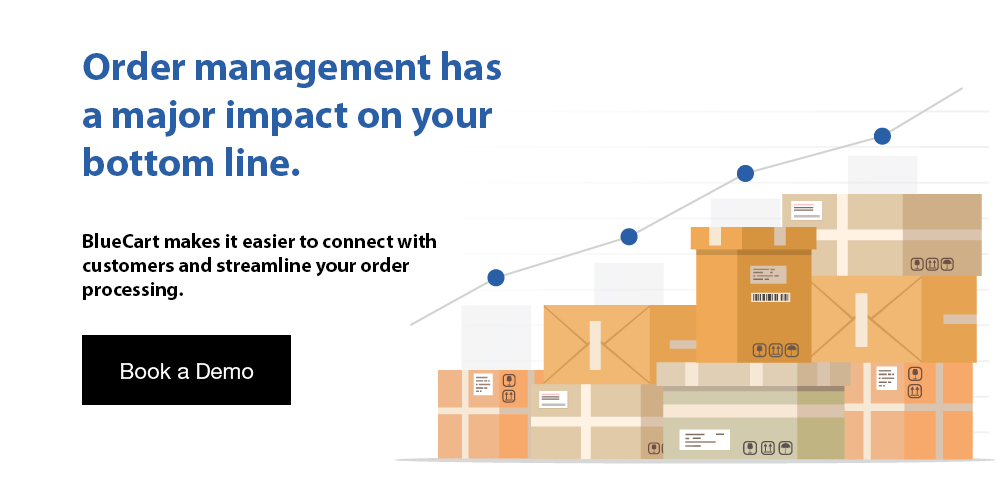Smart warehouses are the future of logistics and supply chain management. With the rapid advancement of technology, warehouses are no longer just a place to store goods, but have become intelligent and automated systems that can optimize and streamline warehousing operations.
Key Takeaway: As a wholesale distribution company, broadliner, and B2B online ordering business owner, it is important to have an infrastructure in place to manage your inventory. Whether its a small distribution warehouse or a bigger, more automated warehouse, it is vital to integrate the latest technology in your warehouse operations to keep up with recent eCommerce trends.
The truth is, if you are not already using a type of smart warehouse technology, then your business may be falling behind. From mobile robots and AI in eCommerce to automated picking solutions and warehouse inventory management systems, smart warehouses increase efficient business systems and streamlines your warehouse process flow.

In this article, we will explore what a Smart Warehouse is, its importance in today's business environment, and the benefits it offers. Let’s get started!
What is a Smart Warehouse?
A Smart Warehouse is a highly automated and intelligent warehouse system that utilizes technology to optimize operations and improve efficiency. This includes the use of sensors, RFID technology, and artificial intelligence (AI) to track inventory, manage the movement of goods, and make decisions in real-time.
Smart warehouses are designed to streamline operations, reduce costs, and improve the accuracy of inventory management. Using a smart warehouse system means you can make informed decisions regarding your inventory, staffing, and shipping and handling by automating the process of data collection and analysis.
A practical example of a Smart Warehouse is an automated distribution center that uses RFID technology. The warehouse manager can track inventory and automated systems such as conveyor belts and robotic arms to move goods.
The same warehouse also utilizes artificial intelligence (AI) and machine learning (ML) to make real-time decisions about inventory management, movement of goods, and identifying potential problems. You get the picture! Now let’s paint it clearer.
For example, let's say a coffee wholesale company operates a smart warehouse that uses RFID tags to track the inventory of products. The warehouse management system uses AI and ML to monitor inventory levels in real-time, and make decisions about when to restock certain products or re-arrange the warehouse layout for optimal efficiency.
In addition, the warehouse is equipped with sensors that monitor temperature and humidity. With this, the AI system can adjust the warehouse environment to ensure that perishable goods are stored in the optimal conditions.
The smart warehouse system also provides real-time data and analytics that the company can use to improve their supply chain and logistics operations. This includes real-time inventory levels, shipping and receiving schedules, and information about delivery routes, and route optimization.
By implementing a smart warehouse system, the company can improve efficiency, reduce costs, and improve inventory management. There is also the opportunity to provide a better customer service by enabling faster and more accurate order fulfillment.
Smart Warehouse System
A smart warehouse system is made up of several components that work together to make the warehouse more efficient and effective. These components include sensors and RFID technology, used to track inventory, inventory control, and stock management.
The system also includes software that integrates all of the components and allows for real-time decision making, such as monitoring inventory levels and identifying potential problems. An example of how the components of a smart warehouse system work can be seen in a company that specializes in the distribution of wholesale restaurant supplies.
- Sensors and RFID technology located throughout the warehouse, including on shelves and on the products themselves. This allows the warehouse management to monitor inventory levels and ensure that products are being moved efficiently.
- Automated systems such as conveyor belts and robotic arms to automatically retrieve the products from the shelf and place them on the conveyor belt, which will then transport them to the packaging and shipping area.
- Software system that integrates all of the components to analyze the data collected by the sensors and make decisions such as reordering products that are running low, identifying potential problems, and optimizing the movement of goods.
- Artificial intelligence (AI) and machine learning (ML) to analyze data from the sensors and identify patterns, such as a high rate of damages on a particular product and then suggest solutions such as re-packaging or handling the product differently.
All of these components work together to create a highly efficient and automated warehouse system that can improve the speed and accuracy of order fulfillment, reduce costs, and improve inventory management.

Intelligent Warehouse Technology
Intelligent warehouse technologies work together to create a smart warehouse. With these technologies in place, the warehouse operations are optimized and streamlined, increasing efficiency, reducing errors and costs, and improving inventory accuracy and visibility.
These technologies include:
- Sensors and RFID (Radio Frequency Identification) technology: These technologies are used to track inventory and monitor the movement of goods within the warehouse. RFID tags are placed on items and the tags are then read by RFID readers, which can provide real-time information about the location and movement of goods.
- Automated systems: Automated systems such as conveyor belts and robotic arms are used to move goods and improve efficiency. These systems can help to reduce the need for manual labor, increase speed and accuracy, and improve safety.
- Artificial Intelligence (AI) and Machine Learning (ML): AI and ML algorithms are used to make decisions in real-time, such as identifying potential problems, optimizing the movement of goods, and improving inventory management. These technologies can also be used to analyze data and make predictions about future demand, which can help companies to better plan their operations.
- Cloud-based software: Cloud-based software is used to integrate all of the technology systems within the warehouse. This software allows for real-time decision making, such as monitoring inventory levels, optimizing the movement of goods, and identifying potential problems.
- Internet of Things (IoT): IoT devices can be used to gather data and provide real-time monitoring and control of warehouse operations. This can provide insights on things like temperature, humidity, and other environmental conditions, allowing for greater control and accuracy in the warehouse.
3 Benefits of a Smart Warehouse
So, what are the benefits of smart warehouses? Let’s find out.
- Improved Efficiency and Productivity
Smart warehouses utilize advanced technology and automation to streamline operations and improve efficiency. This includes the use of sensors and RFID technology to track inventory, automated systems such as conveyor belts and robotic arms to move goods, and AI and ML algorithms to make decisions in real-time. These technologies can help to reduce the need for manual labor, increase speed and accuracy, and improve safety, all of which can lead to improved efficiency and productivity.
- Reduced Costs and Errors
Smart warehouses can help to reduce costs by optimizing operations and reducing the need for manual labor. Automated systems can also reduce the number of errors that occur during the movement and tracking of goods. This can lead to lower costs associated with waste, lost inventory, and lost productivity.
- Increased Inventory Accuracy and Visibility
Smart warehouses utilize advanced technology such as sensors and RFID technology to track inventory in real-time. This allows for accurate and up-to-date information on inventory levels, which can help companies to better plan their operations and meet customer demand. Additionally, real-time tracking and monitoring can help to reduce the risk of lost or misplaced inventory, improving inventory accuracy and visibility.

Frequently Asked Questions About Smart Warehouse
Here are frequently asked questions about smart warehouse systems:
What are the Three Major Types of Warehouses?
The 3 major types of warehouses are:
- Manufacturing and distribution warehouses
- Retail warehouses
- Public warehouses
What are the 4 Basic Functions in a Warehouse?
The four basic functions in a warehouse are:
- Receiving
- Storing
- Picking and Packing
- Shipping
What are the 6 Warehouse Technologies?
The 6 warehouse technologies include:
- Automated storage and retrieval systems (ASRS)
- Warehouse Management Systems (WMS)
- Barcode and RFID technology
- Conveyor systems
- Automated Guided Vehicles (AGV)
- Robotics